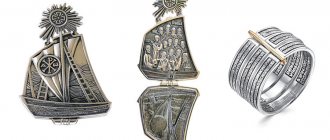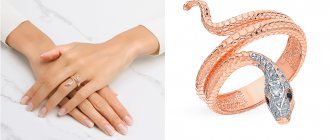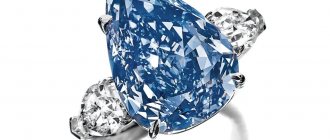“Saltykov-Shchedrin: if in a hundred years they ask me what is happening in Russia now, I will answer: Sunlight stores are closing,” “It is still not known for certain whether there are dinosaurs, megalodons and people left on Earth who believe in the next closure of Sunlight” - to these and other funny tweets that have filled RuNet in recent months, users were inspired by an advertisement for one of the most scandalous jewelry chains in Russia, Sunlight. In it, company representatives report that the chain is closing and selling the goods “for next to nothing.”
In fact, this is not so: the chain has been “liquidated” for several years now, and its stores are still operating in many Russian cities. So, in August 2019, the page said that “Sunlight stores in your city are closing” and the goods are being sold “with discounts of up to 80%.” A year earlier, messages about similar closures “in your city” appeared on the pages of regional communities about discounts and promotions. You can also find messages from 2017 in online communities. Now on the official website of Sunlight there is a banner with the inscription “Sorry, we are closing stores in the city (the name of the city may change. - Forbes). We sell out the last one up to -80%.” At the same time, the list of closing stores in Moscow includes points that are still operating today and, according to representatives of the shopping centers in which the stores are located, the tenants do not intend to move out.
Such marketing gives good results - people are eager to get goods at a supposedly bargain price and are ready to make spontaneous purchases. It is difficult to assess the effectiveness of this advertising move alone, but the total number of Sunlight stores has been growing in recent years: if in 2014 the network had 258 points, and the company was in sixth place in the number of jewelry stores under its own brand in Russia, then in 2021 Sunlight moved to second place after “585*Zolotoy” (830 points), increasing the number of stores to 385 (data from RBC.Research reports “Retail chains selling jewelry” for the corresponding periods). In 2020, according to the co-founder of the network, Sergei Gribnyakov, the network has 350 points (380 points are listed on the Sunlight website). “It’s not a fact that this is what influenced the growth of the network, but it could have been one of the factors, since all the other [jewelry chains] at that time were doing toothless advertising,” says Alexander Tarasov, ex-director of the promotion department of the 585*Golden group. . — This move can be called the Sunlight trick. Competitors at first did not believe that there was an effect, and then began to imitate it.”
Advertising on Forbes
In 2021, the wave of hype raised around the “liquidation” of Sunlight reached its peak, says Dmitry Sidorin, founder of the Sidorin Lab agency: from the beginning of August to mid-September 2021, 20 times more mentions of the network appeared in Runet than in the previous ten years extra months. This suggests that the action has become truly viral, primarily thanks to “folk art” in the form of numerous humorous memes, Sidorin believes.
Forbes met with the founder of the network, Sergei Gribnyakov, who is usually extremely closed to the press, and tells how he managed to revolutionize the complex jewelry market and earn billions of rubles from “affordable” diamonds, why he does not consider statements about the annual “liquidation” of the company to be a hoax, and how refers to Sunlight becoming an internet meme.
The Way of Onyx
The founders of Sunlight, Sergei Gribnyakov and Alexey Konovalov, gave the first and only detailed interview to RBC magazine in 2015. At first, they also did not respond to Forbes’ request for this material, but on the eve of publication, Gribnyakov still agreed to meet - however, during the approval process he deleted most of his quotes.
A graduate of the engineering faculty of the Novocherkassk State Reclamation Academy, Gribnyakov, together with his school classmate Mikhail Maslovsky and acquaintance Alexei Konovalov, began developing their own jewelry retail in 2009. Before this, the partners had been developing a wholesale jewelry business for about ten years. Gribnyakov and Maslovsky were its founders, and Konovalov came to Onyx in the 2000s as IT director, but over time became a co-owner.
At first, Onyx made money by distributing and selling Russian goods, Bronnitsky Jeweler, etc. And in the early 2000s, it also began importing jewelry from China. “The Chinese then successfully began to copy the Italians - they were essentially engaged in high-quality stamping, plus they figured out how to make products cheaper,” recalls Alexander Tarasov, ex-director of the promotion department of the 585*Zolotoy group. — Instead of diamonds, we started using diamond chips - leftovers from the production of more expensive products with large stones. The jewelry with them looked no worse, and was much cheaper.”
At the turn of the 2000s, the jewelry market grew by leaps and bounds, recalls Eduard Utkin, director of the Guild of Russian Jewelers: “Everything was sold, but the entry price was a pittance. Only the lazy could not grow and earn money.”
#7. Yam
Gold Plated Highgate Dangle Earrings
New York designer Morgan Thomas has been interested in jewelry since her teenage years, when she first opened a book on jewelry making. Now, under her leadership, they produce original jewelry, imbued with nostalgia for the bright times of the 1970s and 1980s.
Copy error
In the mid-2000s, the owners of Onyx decided, instead of importing little-known brands, to start developing their own brand: they found production facilities in China and came up with the name Sunlight in the manner of foreign jewelry brands (later the Onyx brand ceased to exist, but legal entities with this word in the name operate) . At first they didn’t open their own stores: they decided to sell Sunlight products in multi-brand stores, with which they had previously worked as wholesale suppliers. This is how bright corners with red display windows appeared in partner jewelry stores. In 2009, the company opened its first Sunlight brand store in the Crocus City Mall shopping center near Moscow. By that time, according to Gribnyakov, the brand’s products were already sold in more than a hundred points throughout Russia.
It is quite difficult to calculate the total income of the network at that time: Sunlight worked on behalf of a number of legal entities, the exact number of which is difficult to establish (Gribnyakov refused to answer this question). According to SPARK-Interfax, in 2006 the legal entity Onyx-Center was registered (its general director is Konovalov), which in 2008 showed revenue of 275.5 million rubles and a profit of about 300,000 rubles. Several more legal entities with the type of activity “wholesale or retail trade in jewelry” - “Onyx Mall”, “Fashion Gold” and “Sunlight Center” - began operating in 2008-2009. They belonged to Red Matrix Trading, a company registered in Cyprus, which later became the owner of 100% of Onyx-Holding, which supplies goods to all franchisees of the network. Among the co-owners of Fashion Gold LLC is also Sunlight co-founder Alexey Konovalov. The total revenue of Onyx Mall, Fashion Gold and Sunlight Center in 2008, according to SPARK, amounted to 360 million rubles, in 2009 - already 915 million rubles, and in 2010 - about 1.2 billion rubles. Profit is about 700,000 rubles, 3.7 million rubles and 5.7 million rubles, respectively.
“It was nonsense: people with bags from Auchan crowd into Sunlight and buy jewelry”
Such rapid revenue growth is not surprising, Tarasov believes. Firstly, the Sunlight brand appeared in the post-crisis period with “the right offer for its target audience: jewelry in “fresh modern forms” with scattered diamonds instead of solitaire diamonds (large stones) and blown (hollow) ones that cost 1.5 times more. gold instead of solid, says the former manager of 585*Gold. Due to this, the average check for the chain was less than 3,000 rubles, RBC quoted one of the company’s former top managers as saying. For comparison: Pandora, which operates in the middle and premium price segments, had an average bill of 6,000–7,000 rubles. “We needed something to be different from our competitors, and that something was the price offer,” admits Gribnyakov. Sunlight’s audience was young people who “wanted to buy jewelry, but could not afford expensive ones yet,” says Mikhail Egorov, founder of the jewelry studio Ring Studio.
The second reason for the successful start of Sunlight is the format of the stores, Tarasov believes. “The Adamas, Altyn and other stores at that time were like a Turkish collapse: an abundance of gold goods on the shelves, pawn shops integrated into the stores. And Sunlight made a copy of the European format: boutique interior, sparse display of jewelry on the shelves, beautiful packaging. Selling in the mass market, they wrapped the product in premium packaging,” the expert lists.
Photo DR
Another characteristic feature of Sunlight’s work at the start was the copying of successful practices of competitors, Tarasov notes. Since 2009, the company began producing charms - small pendant beads that are strung on bracelets, which were then considered a “feature” of the Pandora brand. “Sunlight released these charms and captured the mass market with them. It was just an amazing move,” recalls the ex-manager of “585*Golden”. A Pandora representative told Forbes that the company cannot comment on Sunlight's marketing policies.
In 2021, Sunlight accused the Ural brand Avgvst of copying another piece of jewelry—lollipop-shaped pendants. According to Avgvst founder Natalya Bryantseva, Sunlight “chups” completely repeat the proportions and methods of fastening products that she developed back in 2015. “In the summer of 2021, we received a flurry of messages from our clients who saw pendants similar to ours in Sunlight,” says the entrepreneur. She also claims that a competitor copied a photo in their advertising campaign. “They later apologized for copying the campaign photo and promised to remove it from social networks. But they did not respond to demands to remove the products from sale, since they copy something that does not have a patent,” says Bryantseva. Due to the lack of a patent, Avgvst did not file any formal complaints. Sunlight still sells pendants in the shape of lollipops.
Gribnyakov refused to answer questions about charms and pendants in the shape of lollipops.
French jewelry brands
1. Cartier
Year of foundation: 1847
French Cartier jewelry is synonymous with luxury and chic. Consider the fact that throughout the twentieth century, their crowns were worn by representatives of royal families throughout Europe! The precious panther on accessories has turned into a real talisman and symbol of success for French craftsmen. The brand's iconic masterpieces are the 1888 women's bracelet watch and Trinity ring. In addition to the classic set of jewelry, Cartier also creates pens and lighters. Cartier is also considered the inventor of clip-on earrings without a clasp.
Rose gold in a triple ring symbolizes love, yellow – fidelity, and white – friendship
2. Boucheron
Year of foundation: 1858
The company's strength lies in its ability to turn extravagant and bold decisions into beloved classics. Recognizable symbols of Boucheron are jewelry in the form of a snake, a ring with a chameleon, and ivy branches. The brand's signature is manifested in the use of colored precious stones, Oriental motifs, flowers and wild animals, and feathers. The basis of the concept is extravagance, scope and courage in decisions. Boucheron was the first to release watches with an interchangeable strap.
In 2004, another symbol of the brand appeared - the Quatre ring made of pink, white, yellow gold and ceramics, which instantly became iconic. And decorations from the Animaux collection in the form of animals have become mascots for thousands of girls.
Ivy leaves are a favorite motif for inspiration in Boucheron creations
3. Van Cleef & Arpels
Year of foundation: 1896
The brand's calling card is motifs of flora and fauna, fairy-tale characters. Van Cleef & Arpels were pioneers in many ways. They were the first to introduce a bracelet watch with a hidden dial. Also, the world was once surprised by a zipper necklace, which, once fastened, is worn like a bracelet. And you can’t take your eyes off the shining Van Cleef & Arpels Ballerina and Fairy diamond brooches in the form of dancing ballerinas and fairies! One of the most recognizable and at the same time copied luxury jewelry in the world is the legendary Alhambra necklace with a quatrefoil.
The legendary Alhambra necklace is named after the palace of the Muslim Nasrid dynasty
Franchise surge
An even sharper increase in Sunlight's revenue began after the launch of franchising in the summer of 2011. Under it, Gribnyakov and partners registered two new legal entities, Onyx-Holding (owned by the Cyprus offshore Red Matrix Trading) and Onyx Trading. They decided not to take a lump-sum fee and royalties from the franchisees - instead, the partners had to sell only Sunlight brand products, earning, according to Gribnyakov, about 30-40% on the markup. The costs of opening a franchise outlet were about 350,000 rubles (excluding rent) and “were at least 5 times less” than other jewelry franchises, Georgy Petrov, one of the chain’s franchisees in Kaliningrad, told RBC. “Compared to Adamas, 585 and other large chains, [Sunlight’s] conditions were light,” confirms Franshiza.ru founder Nina Semina.
By April 2012, the partner network, according to the company itself, had grown to 130 facilities operating in Krasnodar, St. Petersburg, Samara, Togliatti, Yekaterinburg, Nizhny Novgorod and other cities. Many owners of stores through which Sunlight previously sold its goods also became franchisees, Gribnyakov assures: “Nothing has changed for us - we supplied the same people with the same goods, only now to the franchise point.”
Advertising on Forbes
In Moscow and the Moscow region, the company developed only its own retail. In 2013, the entire chain grew to 272 stores, two thirds of which were franchised. According to the “Retail Jewelry Chains 2015” report prepared by the RBC research division, the number of Sunlight stores from 2011 to 2013 increased from 125 to 277.
Sunlight stores were located mainly in shopping centers - this is how the company gained access to traffic, says Tarasov. To make itself known inside the shopping center, the brand carried out partnership promotions with retailers: at the checkout of grocery stores and household appliance stores, it offered to receive jewelry as a gift or purchase it at a discount. “For us at that time it was nonsense: people with bags from Auchan crowded into Sunlight and bought jewelry,” admits Tarasov from 585*Zolotoy. “We saw the audience of jewelry stores differently.”
But in 2015, the Sunlight franchise program was completely suspended. Gribnyakov comments sparingly on the reasons for this decision. “We just closed franchising as a direction because it’s not competitive, that’s all,” he says. “We agreed with some, and not with others.” But most [former franchisees] kept these stores for themselves: they renamed them and continued to work.” According to Gribnyakov, now 100% of the company’s stores are owned.
Spanish jewelry brands
10. Carrera y Carrera
Year of foundation: 1885
The company's history began as a family business. Now, Carrera y Carrera accessories are recognized by their large-scale scale, eye-catching shades, pronounced symbolism of flora and fauna, exotic motifs, glorification of the beauty of soft lines and silhouettes, interest in Eastern philosophy and sculptural products. The early Las Manos (“Hands”) and the modern Jardín de Rosas (“Garden of Roses”) are collections that reflect the spirit of the brand. Carrera jewelry resembles mini-sculptures and deserves to be called high art.
The brand's jewelry is filled with expression and rich colors
11. Tous
Year of foundation: 1920
The Spanish brand began its history with watch repairs, but in 1965 Tous declared itself as a jewelry manufacturer. The brand's corporate symbol, a bear, was born in 1985. It symbolizes pleasant childhood memories. The brand's jewelry is characterized by lightness, smooth lines, and bright gems reminiscent of candy canes.
Even in cocktail rings or statement necklaces there is no pomp or excessive pretentiousness. That’s why you can read youthful enthusiasm and sparkling mood in them. The calling card of Tous is collections for family holidays, couple jewelry, talismans for lovers.
Tous love creating light and cheerful accessories
Golden time
In 2011, when franchising just started, the revenue of the main legal entity responsible for working with partner outlets, Onyx-Holding, amounted to 2.9 billion rubles, profit - about 6 million rubles, and in 2014 - already 6 billion rubles and 89 million rubles, respectively, according to SPARK-Interfax data. Gribnyakov refuses to comment on the company’s financial performance. In a conversation with RBC, Sunlight co-owner Alexey Konovalov, however, said that the company’s revenue in 2014 was “a little more”: the Onyx group, according to him, worked through several legal entities. According to Eduard Utkin from the Guild of Jewelers of Russia, in 2014 Sunlight’s revenue could reach 9-10 billion rubles.
However, due to a drop in demand amid a sharp weakening of the ruble at the end of 2014 - beginning of 2015 and a decrease in the incomes of Russians, “things began to decline,” Utkin believes. The number of chain stores by the end of 2014 decreased from 277 to 258, and in 2016 - to 211; during the crisis year, the chain transferred 40 franchise points under its own management, according to the RBC.Market Research report. The revenue of Onyx-Holding (which, after the closure of franchising, apparently began supplying the chain’s own stores), according to SPARK, fell first to 3.6 billion rubles in 2015, and then to 1.7 billion rubles in 2016 Profit: 85 and 45 million rubles, respectively. It was possible to maintain profit despite a sharp drop in revenue thanks to the transfer of production from China and Hong Kong to Kostroma: due to the jump in the dollar exchange rate, Russian production has become three times cheaper, Utkin believes. Today, according to Gribnyakov, Russian-made products account for 80% of all Sunlight products sold. Among the partners are Alcor, Krastsve.
Advertising on Forbes
“Sunlight will still use this advertising, for him a fine of 500,000 rubles is nothing”
At the same time, claims against Sunlight appeared from the Federal Tax Service. At the end of 2021, the service assessed Onyx-Holding about 730 million rubles in VAT and income tax with penalties and fines. In 2021, the company tried to challenge the decision of the Federal Tax Service in the Moscow Arbitration Court, but it sided with the tax service.
The network was found to have evaded paying taxes: according to the Moscow Arbitration Court, the company purchased jewelry products from LLC Bril and LLC Stik, which it controlled, which in turn ordered jewelry from contract manufacturers in China and Hong Kong. Maria Kukla, a partner at the law firm FTL Advisers, explains that the scheme worked as follows: Stik bought jewelry from manufacturers, then made a markup of more than 50% and sold the goods at an already inflated price to Onyx-Holding, follows from the arbitration decision court. The profits received from this scheme by “Bril” and “Stik” were transferred in favor of fly-by-night companies under contracts for pre-sale preparation of products, which were not actually carried out. The main profit from operations was deposited in the “one-day” companies, which allowed the network to evade paying VAT and profit tax in full, Kukla explains the decision of the capital’s arbitration court. “Taxes were additionally assessed to Onyx-Holding LLC, since “Bril” and “Stik” were not independent economic entities, but were part of a group with Onyx-Holding LLC. In this case, the tax was recalculated using the “tax reconstruction” method - additionally assessed by the amount of saved tax payments,” the lawyer adds.
Sunlight lawyer Lyudmila Korneva responded to Forbes’ request that the employees who took part in the audit no longer work for the company, so the network cannot comment on the issue.
Since 2009, the company began producing charms - small pendant beads that are strung on bracelets.·DR
In 2021, Onyx-Holding's income is declining even more: the legal entity's revenue, according to SPARK, amounted to about 685 million rubles, profit - 8.2 million rubles. Another 696.6 million rubles in revenue and 5.6 million rubles in profit were brought in by the new legal entity Solnechny Svet LLC, 100% owned by Gribnyakov since 2021 (this legal entity appears in the privacy policy on the company’s website, and will also later appear in FAS documents related to the brand). However, it is hardly possible to talk about a sharp slowdown in business. The FAS claims dated July 2021 against Sunlight mention another structure - UK Retail Park LLC, which, according to SPARK, manages 18 other legal entities associated with jewelry activities. It also appears in the report “Retail Chains Selling Jewelry 2018”, prepared by RBC.Market Research, as the main structure of the network. In 2014, the turnover of companies managed by UK Retail Park amounted to 2.5 billion rubles, in 2015 - 4.1 billion rubles, in 2016 - 5.9 billion rubles, in 2017 - 8 .9 billion rubles. Sales profit in 2014 amounted to 123.2 million rubles, in 2015 - about 839 million rubles, in 2016 - 2.17 billion rubles. In 2017, when additional taxes were assessed, the structure’s profit decreased to 566 million rubles. Gribnyakov refused to talk about UK Retail Park.
He called the period after the claims from the Federal Tax Service “a difficult time,” but did not comment on the drop in turnover. “There are managers who deal with financial issues, and there are managers who deal with the product and its promotion. I belong to the second group - I am not involved in finance,” Gribnyakov explained his position. But he added that in order to pay off penalties and fines, the company had to take out loans.
Advertising on Forbes
Leave not in English
By 2021, the number of Sunlight points has reached 335, according to data from the report on the jewelry market for 2021, conducted by RBC.Market Research. According to this indicator, the company moved to second place in the Russian market - after the 585*Zolotoy chain with 830 stores. The revenue of Onyx-Holding, according to SPARK, in 2021 amounted to 1 billion rubles, in 2019 - 2 billion rubles. UK Retail Park, which could be the main structure of the company, showed 12.9 billion and 9 billion rubles in revenue and 1.3 billion and about 1 billion rubles in profit in 2021 and 2021, respectively. The revenue of Solnechny Svet LLC, 100% owned by Sergei Gribnyakov, in 2021 and 2021 amounted to 2.4 and 4.1 billion rubles, respectively.
How did the company increase its turnover? The chain, for example, introduced silver jewelry and inexpensive watches into its assortment, which were not available before.
“Often stars announce their retirement from the stage, but again and again they appear in public. Sunlight exaggerated this technique"
Utkin and Tarasov believe that aggressive marketing helped the chain grow in the 2010s, including announcements of “store closures” and “product liquidation.” “We are closing stores in the city ... [the city changes in accordance with the one selected on the site]. We sell out the last one up to -80%” - such banners have repeatedly appeared on the Sunlight website. A video of the same content appeared on the company’s YouTube channel (about 47,000 subscribers) at the end of August. In it, a female voice promised: “In accordance with official protocol, Sunlight jewelry stores are closing on an emergency basis. We are forced to sell all jewelry for next to nothing as quickly as possible. Prices have already been halved, and many jewelry items have 60, 70 and 80% discounts. If you hurry, there will be more choice. Get to Sunlight before it closes.” At the same time, at least some of the stores whose closure Sunlight reported continue to operate to this day. For example, a store in the Columbus shopping center, the address of which is on the list of closing stores, according to Yandex.Maps, is still operating. A manager who answered Forbes' call at the mall's contact number said the Sunlight store in Columbus is open and has no plans to close. It’s a similar story with Sunlight in the Filion shopping center, which is mentioned in the same list of closing points, but according to Yandex.Maps it is operating as usual. This was confirmed by the contact phone number on the Filion website.
Gribnyakov does not consider statements about the “liquidation” of the network to be a deception: “We are constantly closing something, opening something. It's a continuous process. For example, this year we have already closed 62 stores. At the moment, about 350 points are operating.”
The advertising move about “closing stores” is “one of the most successful marketing techniques from time immemorial in the mass market,” Tarasov believes. “It works to create excitement and pushes the consumer to make a spontaneous purchase. “It’s closing, we have to take it,” explains Tarasov. The founder of the Sidorin Lab agency, Dmitry Sidorin, agrees with him: “Often stars announce their retirement from the stage or the end of their sports career, but again and again they go out into public. Sunlight exaggerated this technique, repeating it over and over again, and clearly not by chance - I’m sure such marketing gives a bright surge [of sales], after which failure occurs.”
Advertising on Forbes
Under the magnifying glass of the FAS
Sunlight's aggressive marketing approach has at least one serious drawback: it risks fines from the regulator. The FAS has already paid attention to the network’s advertising: for example, in 2018, the Kurgan OFAS opened a case in connection with the sending of SMS with the following content: “Hello! This is Vera from Sunlight. By March 8, for the first time, we have a 50% discount on all gold, so I personally invite you to visit Sunlight stores and take advantage of a 50% discount on gifts for yourself and your loved ones. See you at Sunlight stores." But the case was later dismissed because Sunlight was able to prove that the subscriber agreed to receive advertising messages. In 2021, the Omsk OFAS decided to fine the company 100,000 rubles for “sending an advertising SMS message to a subscriber without his prior consent.” The resolution came into force only in September 2021, the press service of the FAS Russia told Forbes.
In July 2021, the Volgograd branch of the FAS for the first time recognized Sunlight advertising as violating clause 3 of Part 3 of Art. 5 of the Law on Advertising No. 38-FZ (advertising containing false information about the possibility of purchasing a product in a certain place or within a certain period). Then the antimonopoly agency did not fine Solnechny Svet LLC, but ordered it to stop disseminating information about “leaving the market” and transferred the case materials to “an authorized official to make a decision on initiating administrative proceedings” (the proceedings have not yet appeared in the file of arbitration cases).
The advertising move about “closing stores” is “one of the most successful marketing techniques from time immemorial in the mass market.”·DR
But complaints about the network did not stop and, based on new complaints, the Volgograd OFAS began another inspection of the company. A similar check based on a complaint from a local resident was launched in the Chelyabinsk region.
If the Chelyabinsk or Volgograd OFAS finds the network guilty, it faces a fine of 100,000 to 500,000 rubles, says Vladimir Bublikov, partner of the RKT law firm. A Forbes interviewee familiar with the jewelry market believes that even after these fines, the chain will continue to use the marketing technique of closing stores, because “for it, these 500,000 rubles are nothing.” “This marketing has been working for several years, and everything is fine for the network.” In addition, Sunlight has a chance to get out, Utkin believes: “Now all the chains are closing some stores or moving from one tenant to another, or even just to another location in the same shopping center. Formally, this can also be called closure.”









